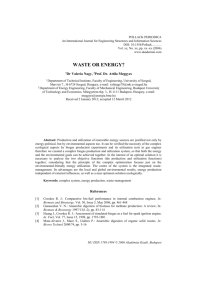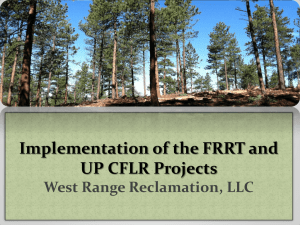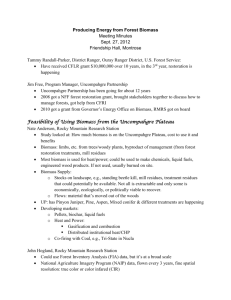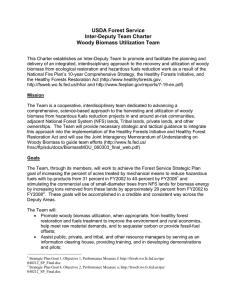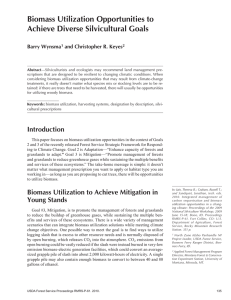Anderson Qstudy on Stakeholders Perspectives
advertisement
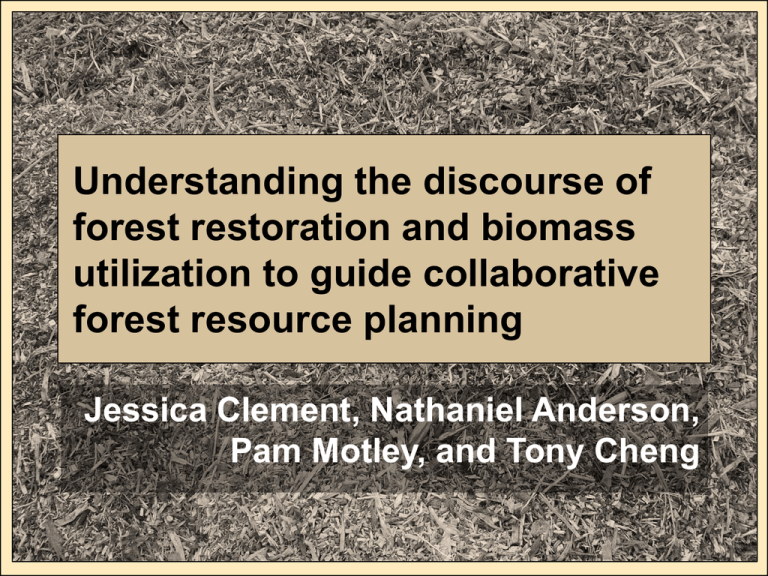
Understanding the discourse of forest restoration and biomass utilization to guide collaborative forest resource planning Jessica Clement, Nathaniel Anderson, Pam Motley, and Tony Cheng What’s ahead? • • • • • Background Goals and Objectives Methods: The Q-study Results Discussion and Questions Research Personnel Colorado Forest Restoration Institute, CSU • Jessica Clement • Tony Cheng Uncompahgre Partnership • Pam Motley (now with West Range Reclamation) Rocky Mountain Research Station • Nate Anderson Partners • • • • • Uncompahgre Partnership/GEO Grant RMRS CSU- CFRI GMUG National Forests Public Lands Partnership Participants, advisors and stakeholders in the study What themes characterize stakeholders’ subjective perceptions and discourse about restoration treatments and biomass utilization? Goals • Understand regional dialogue • Understand different perspectives • Guide communication, cooperation and collaboration • Maximize benefits • Minimize conflict Objectives • Identify distinct themes that characterize different perspectives on this issue • Examine nuances of those themes • Characterize patterns quantitatively • Identify places where frames overlap and diverge Methods The “Q-Study” • Focus on “Frames” • Frame – “a representation of reality that defines the key elements of a situation and its potential outcomes” • Quantifying the subjective • Risk aversion versus risk taking Methods The “Q-Study” 1. Compile a database of statements 2. Sample the database to select 36 representative statements Methods Statement Categories • Aesthetic • Recreation • Ecological • Cultural/Historic • Process/Policy • Economic Photo: Uncompahgre Partnership Methods Sample Statements • “Forest treatments should minimize visual disturbances whenever possible.” • “I don’t think forest treatments have negative impacts on recreationists.” • “It is important to me that forest treatments pay for themselves.” • “I am concerned that biomass harvest will lead to overharvesting and threaten forests.” Methods The “Q-Study” 1. Compile a database of statements 2. Sample the database to select 36 representative statements 3. Compile a “person sample” – NOT a simple random sample of individuals – NOT an opinion survey – Select participants to represent as many perspectives as possible Methods Stakeholder Group Recreation (motorized and non-motorized groups) Representatives of other collaboratives Grazing permittees Conservation groups Federal agency State agency Local government Energy utility industry Forest products industry Biomass utilization interests Landowners Total Participants 5 4 1 7 5 3 5 3 4 2 3 42 Methods The “Q-Study” 4. Data collection – Q-sorts of the 36 statements by participants – Followed by a structured interview 5. Multivariate statistical analysis – Concentrate relationships of many variables into a few pairs of variables called “factors” 6. Interpret the statistical results thorough correlations with statements and people Methods The “Q-Sort” STRONGLY DISAGREE -5 -4 -3 STRONGLY AGREE -2 -1 ~~~~~~~~~~~~~ ~~~~~~~~~~~~~ ~~~~~~~~~~~~~ ~~~~~~~~~~~~~ ~~~~~~~~~~~~ ~~~~~~~ ~~~~~~~~~~~~~ ~~~~~~~~~~~~ ~~~~~~~~~~~~~ ~~~~~~~ ~~~~~~~ 0 +1 ~~~~~~~~~~~~~ ~~~~~~~~~~~~ ~~~~~~~ ~~~~~~~~~~~~~ ~~~~~~~~~~~~~ ~~~~~~~~~~~~~ ~~~~~~~~~~~~~ ~~~~~~~~~~~~ ~~~~~~~~~~~~ ~~~~~~~~~~~~~ ~~~~~~~~~~~~ ~~~~~~~ ~~~~~~~ +2 +3 ~~~~~~~~~~~~~ ~~~~~~~~~~~~ ~~~~ ~~~~~~~~~~~~~ ~~~~~~~~~~~~~ ~~~~~~~~~~~~ ~~~~~~~~~~~~ ~~~~ ~~~~~~~~~~~~~ ~~~~~~~~~~~~~ ~~~~~~~~~~~~~ ~~~~~~~~~~~~~ ~~~~~~~~~~~~~ ~~~~~~~~~~~~~ ~~~~~~~~~~~~ ~~~~~~~~~~~~~ ~~~~~~~~~~~~~ ~~~~~~~~~~~~ ~~~~~~~ ~~~~~~~~~~~ ~~~~~~~~~~~~~ ~~~~~~~~~~~~~ ~~~~~~~ ~~~~~~~ ~~~~~~~~~~~~~ ~~~~~~~~~~~~~ ~~~~~~~~~~~~~ ~~~~~~~~~~~~ ~~~~~~~~~~~ ~~~~~~~~~~~~~ ~~~~~~~~~~~~~ ~~~~~~~ ~~~~~~~~~~~~~ ~~~~~~~~~~~~~ ~~~~~~~~~~~~ ~~~~~~~ ~~~~~~~~~~~~~ ~~~~~~~~~~~~~ ~~~~~~~~~~~~~ ~~~~~~~~~~~~~ ~~~~~~~~~~~ ~~~~~~~~~~~~~ ~~~~~~~~~~~~~ ~~~~~~~~~~~~~ +4 +5 ~~~~~~~~~~~~~ ~~~~~~~~~~~~~ ~~~~~~~~~~~~~ ~~~~ ~~~~~~~~~~~~~ ~~~~~~~~~~~~~ ~~~~ Results FACTOR 1: Bio-centric Utilization • 20 of 41 participants • 34% of variation in the data • Generally supportive of biomass utilization for ecological reasons, with an emphasis on accomplishing treatments to improve ecosystem health and avoid severe fires. • “The Plateau contains important habitat for various species of wildlife. Treatment activities should not degrade habitat.” Results FACTOR 2: Industry-oriented Utilization • 10 of 41 participants • 19% of variation in the data • Supportive of biomass utilization to generate economic benefits, including job creation in new and existing industries. Also aware of and supportive of other values. • “It is critically important to industry to have a sustainable, predictable supply of material.” Results FACTOR 3: Industrialist • 3 of 41 participants • 6% of variation in the data • Highly correlated with statements characterizing open burning of biomass as a wasteful activity. High emphasis on jobs. Low support for other values. • “Using woody biomass instead of wasting it by burning or scattering on the ground has numerous benefits.” Results FACTOR 4: Access-oriented Utilization • 3 of 41 participants • 5% of variation in the data • Emphasis on access and motorized recreation with support for industry. • “I love to explore the large network of Off Highway Vehicle roads and trails that the Uncompahgre Plateau offers.” Results FACTOR 5: Risk-averse Eco-centric • 3 of 41 participants • 4% of variation in the data • Ecological emphasis generally skeptical of utilization and disagreeing with statements supporting utilization for economic reasons. • “Treatment emphasis should be on improving and maintaining ecosystem health.” Results • Loadings relate sorts to factors • Respondents load uniquely to one factor Participant # 21 4 18 34 24 7 16 33 13 40 14 8 3 15 17 41 5 32 6 12 Factor 1 Factor 2 Factor 3 Factor 4 Factor 5 0.8310 0.8001 0.7826 0.7638 0.7589 0.7308 0.7105 0.6755 0.6713 0.6629 0.6585 0.6532 0.6420 0.5978 0.5892 0.5712 0.5405 0.5248 0.5021 0.4670 Participant # Factor 1 Factor 2 Factor 3 Factor 4 Factor 5 28 0.7896 38 0.7860 30 0.7642 2 0.7516 10 0.7503 37 0.7275 11 0.6991 31 0.6522 29 0.6419 19 0.5151 23 0.7355 25 0.7012 1 0.6109 35 0.7479 26 0.7116 9 0.6639 27 0.6388 39 0.6172 36 0.6037 Q-sorts loaded on each factor at p < .01. Take Home Messages • The dominant perspectives tend to appreciate multiple values • The dominant perspectives are not highly correlated with polarizing statements • Is collaborative forest planning the cause or the effect? Or both? • How can we use this information? Photo: Uncompahgre Partnership Contact Information Nate Anderson, Research Forester Rocky Mountain Research Station PO Box 7669, 200 East Broadway Missoula, MT 59807 nathanielmanderson@fs.fed.us (406) 329-3398
